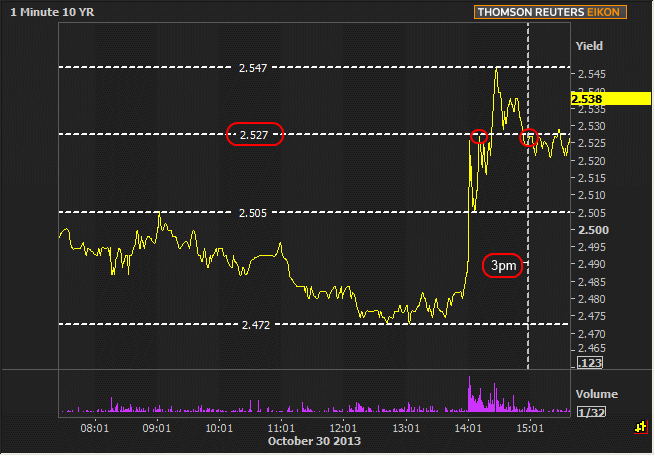Yesterday
- MBS Traded to highest highs and lowest lows of 1-week range in 30 minute window
- Culprit 1: weak ADP employment numbers helped in the morning
- Culprit 2: FOMC Announcement with absence of bearish undertones hurt in the afternoon
- Maximum possible movement while maintaining the range (chart 1 below)
Today
- Data is less intense. Jobless Claims and Chicago PMI are relevant
- Month-End trading considerations for bond markets (innate motivation of uncertain direction)
- Important day (1 of 2) for technical indicators
Strategy
A quick note about yesterday: The post-FOMC sell-off surprised many market-watchers. It was a bit surprising at first, but less so when taking a step back and considering that MBS and Treasuries both did just about everything they could to end up back on the other end of the week-long post-NFP trading range.
As for the surprise, we've discussed for several weeks now that this FOMC statement wasn't likely to offer any policy changes and might even give some guidance in the form of a more economically bearish tone. After all, employment metrics continue to worsen and there's another looming fiscal battle coming up in Q1-2014.
Instead, the Fed was rather indifferent to recent economic challenges and even removed their previous note about "tightening financial conditions observed in recent months." Between the general absence of new concern and the removal of that specific passage--and knowing full well that the Fed sees what we're seeing insofar as the needs to hold off on tapering--we can only guess that the Fed thinks interest rates are pretty livable right about here.
That brings us to the "short story." Why does the Fed think rates are livable right here? What follows is basically a mock dialogue from unassigned voices within the Fed over the past 6 months. They're not meant to represent any particular Fed gov, but rather the FOMC's collective unconscious and plain old common sense:
May 3rd:
Fed 1: Oh man... Did you see that April jobs report totally undo all the drama from the March report?
Fed 2: Umm... Yeah... 10yr notes are at 1.6-ish... We may need to start backing out the accommodation at some point.
Fed 1: Yea think?! We may have needed to start backing it out in late 2012, but everyone was all geeked out over the fiscal cliff.
Fed 2: Well that's why we sent the fringy troops to the front lines with the taper talk in February, right?
Fed 1: Yeah, duh.. And Benny made things real clear in March as well, but then that damn March NFP printing at 88k--what the hell is going on at the BLS? That's just ridiculous.
Fed 3: Hey guys, you realize the housing market is getting a bit bubbly, no? And you also realize that we're buying a crapload of MBS? Anyone seeing the 2 birds with one stone that I'm seeing?
Fed 1: That's evil dude. My cousin is an originator and the calamity created by taper talk will destroy the refi biz
Fed 3: Who cares. These guys are whiners. I had a 13% rate on my house in 1982 and you don't see me complaining. Kids these days need to toughen up. Besides, some guy on CNBC said he thought QE3 accounted for about 60 bps in 10yr yields. They can surely handle a move from 1.60 to 2.2, right? <mocking voice> OMG, 2.2. Oh noes! What will we ever do with these yields that are 80bps lower than they ever thought about being for the last 30+ years?! Give me a break. If you're so concerned about it, we can have another 'suggestive lunch' with Hilsenrath and he'll grease the skids for us.
Fed 1 and 2: Fine. Call Johnny
<fast forward to late June>
Fed 1: Well well well... Mr Fed 3... Where's your CNBC guy now with his 60bps prediction? Pretty sure we just doubled it...
Fed 3: Yeah, well maybe we should have given markets a break on the 19th instead of coming out with both guns blazing.
Fed 1: At least we didn't taper yet.
Fed 2: you guys better hope the Jobs report doesn't crush it on the 5th.
<fast forward to July 5th>
Fed 1, 2, and 3: Crushed it... Crap
Fed 1: OK, well, we obviously bit off more than we could chew with the aggression level of the taper talk. Time for some damage control.
Fed 2: Yeah, we need to avoid another 1999 or 1994. I guess they're going to trade yields in lock-step with taper expectations, so would it be too simple to just start casting doubt on that? We can keep the fringy guys saying their normal stuff so that we make it look like we're undecided and divided. Then when we don't taper in September like they're all expecting, that should put 10yr rates right around 2.5 or slightly lower.
<fast forward to 2 days ago>
Fed 2: OK, well September's "no taper" announcement got rates headed in the right direction. 3.0% was silly so soon, but sub-2.75, I'd be OK with if they can handle it.
Fed 1: Yeah, 2.25-2.75 range seems like a good one for us to target. Shall we say 2.50 as a short term mid-point? After all, we don't really want them to get too riled up and trade rates so low that there's any sort of repeat of May/June 2013. They need to remember that if data improves, rates will go higher.
Fed 3: Well, we could just not add all that incrementally bearish stuff that we'd usually add into an announcement that followed 6 weeks of data as lackluster as the last 6.
Fed 1: Nice. We could even take out the thing about the tight financial conditions, essentially leaving a reminder that 2.5% isn't "tight" and they shouldn't really expect us to bend over backwards facilitating anything lower unless our hand is really forced by deterioration in data.
Fed 3: Someone ate their wheaties. I wonder if anyone realizes how cut and dry this is?
This isn't an attempt to poke fun at the Fed, but rather, it's to show how simple the thought process COULD be when it comes to yesterday's announcement. Rates were too low for comfort in April, too high for comfort into the summer, and maybe they're "just right" now--or at least the Fed would rather see if they're low enough at current levels.
Bottom line, 10yr yields around 2.5 and mortgage rates near 4% isn't going to look like a situation where the Fed needs to hit the afterburners during the flight from 3% 10yr yields and 4.875% mortgage rates. As such, yesterday's statement was simply the Fed's way of taking a 'wait and see' approach.
The message was pretty clear in terms of the immediacy and conviction of the movement in bond markets, but the size of the move wasn't too terribly special. That will be apparent in the first set of charts below.
Less apparent is the technical battle that will now be fought to determine if we lead-off into stronger or weaker territory ahead of next week's NFP. Most of the technical indicators in today's second chart raise red flags about potential bearish risks. In other words, the technical studies are at risk of confirming more momentum higher in rates.
Thankfully, this wouldn't last long if NFP was weak, and it may not happen at all. That's what today is about, and the final chart has some lines in the sand to watch. Notably, Treasuries made it back to 2.527 for the important 3pm close. If we duplicate that today and tomorrow, the threatening technical patterns would be more-or-less defeated. A break above 2.547 could hearken more badness; below 2.505, more goodness.
Charts
Revisiting yesterday morning's "holding pattern" narrow ranges to see that, for all of yesterday's ostensible drama, trading levels were very close to simply trading from one end of the recent range to the other.

Several technical studies suggesting that we should be assessing the risk of a bounce higher in rate. These sorts red flags are typically less of a concern in a market that is trending in either direction, and rates are arguably still trending lower. Even so, they're a concern, but will ultimately be overridden or endorsed by next week's NFP.

Yesterday's moves in 10yr yields, showing how 10's sneaked back under the initially supportive ceiling for the 3pm close. 3pm matters for bond markets because this is the time of day that mosts analysts/traders/economists/etc "mark" the day's close in Treasuries. This in turn affects positions and technical studies in the longer term. Bottom line: closing at 2.527 will make for a more constructive longer term chart when we back away and no longer see the afternoon run up to 2.545.

|
Week Of Tue, Oct 28 2013 - Fri, Nov 1 2013 |
|||||
|
Time |
Event |
Period |
Unit |
Forecast |
Prior |
|
Mon, Oct 28 |
|||||
|
09:15 |
Industrial output |
Sep |
% |
0.4 |
0.4 |
|
10:00 |
Pending sales change |
Sep |
% |
-0.1 |
-1.6 |
|
13:00 |
2-Yr Note Auction |
-- |
bl |
32.0 |
-- |
|
Tue, Oct 29 |
|||||
|
08:30 |
Retail sales |
Sep |
% |
0.1 |
0.2 |
|
08:30 |
Producer price index |
Sep |
% |
0.2 |
0.3 |
|
09:00 |
Case Shiller Home Prices |
Aug |
% |
0.8 |
1.8 |
|
10:00 |
Consumer confidence |
Oct |
-- |
76.0 |
79.7 |
|
10:00 |
Business inventories |
Aug |
% |
0.3 |
0.4 |
|
13:00 |
5-yr Treasury Auction |
-- |
bl |
35.0 |
-- |
|
Wed, Oct 30 |
|||||
|
07:00 |
MBA Mortgage market index |
w/e |
-- |
-- |
454.5 |
|
07:00 |
MBA 30-yr mortgage rate |
w/e |
% |
-- |
4.39 |
|
08:15 |
ADP National Employment |
Oct |
k |
154 |
166 |
|
08:30 |
GDP Final (resched) |
Q3 |
% |
2.0 |
2.5 |
|
08:30 |
CPI mm, sa |
Sep |
% |
0.2 |
0.1 |
|
13:00 |
7-Yr Note Auction |
-- |
bl |
29.0 |
-- |
|
14:00 |
FOMC Announcement |
N/A |
% |
-- |
-- |
|
Thu, Oct 31 |
|||||
|
08:30 |
Initial Jobless Claims |
w/e |
K |
340 |
350 |
|
08:30 |
Consumption, adjusted mm |
Sep |
% |
0.2 |
0.3 |
|
09:45 |
Chicago PMI |
Oct |
-- |
55.0 |
55.7 |
|
Fri, Nov 1 |
|||||
|
08:30 |
Housing starts number mm |
Sep |
ml |
0.908 |
0.891 |
|
08:30 |
Building permits: number |
Sep |
ml |
0.935 |
-- |
|
10:00 |
Construction spending |
Sep |
% |
-- |
0.6 |
|
10:00 |
ISM Manufacturing PMI |
Oct |
-- |
54.7 |
56.2 |





